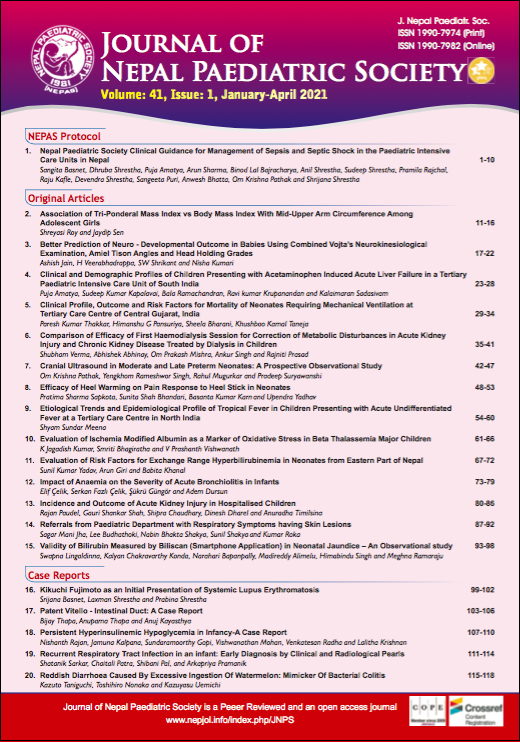Evaluation of Risk Factors for Exchange Range Hyperbilirubinemia in Neonates from Eastern Part of Nepal
DOI:
https://doi.org/10.3126/jnps.v41i1.31040Keywords:
Hyperbilirubinemia, Neonate, Risk factorsAbstract
Introduction: Neonatal hyperbilirubinemia continues to be the commonest cause of nursery and NICU admissions and readmissions in the neonatal period worldwide. Although most cases are physiological, toxic levels of un-conjugated bilirubin can lead to acute and chronic bilirubin encephalopathy. Hence, this study aimed to study the risk factors for exchange range hyperbilirubinemia in neonates.
Methods: This was a hospital-based prospective observational study conducted in a teaching and referral NICU over a period of one year from July 2019 to August 2020. All neonates with diagnosis of hyperbilirubinemia requiring double volume exchange transfusion were included in the study. Risk factors for significant hyperbilirubinemia were analysed with descriptive statistics. P-value of < 0.05 was considered significant wherever applicable.
Results: The mean gestational age and birth weight were 38.06 ± 2.13wks and 2611.72 ± 389.39 gm respectively. Fifteen percent of the babies (162) developed hyperbilirubinemia and 28 (17.3%) required double volume exchange transfusion. Among neonates requiring exchange transfusion, 17 were females and 11 were males. Among 28 babies who required DVET, 20 (71.4%) were SGA. ABO incompatibility was present in 14 (50.0%) neonates and Rh incompatibility in 13 (46.4%) neonates. ABO along with Rh incompatibility was present in eight (28.6%) neonates. DCT was positive in six neonates with ABO incompatibility and nine neonates in Rh incompatibility. G6PD deficiency was present in four (14.3%) neonates.
Conclusions: The most important risk factors identified were small for gestational age, ABO and Rh incompatibility followed by oxytocin use and sibling treated for jaundice.
Downloads
Downloads
Published
How to Cite
Issue
Section
License
Authors who publish with this journal agree to the following terms:
Authors retain copyright and grant the journal right of first publication with the work simultaneously licensed under a Creative Commons Attribution License that allows others to share the work with an acknowledgement of the work's authorship and initial publication in this journal.
Authors are able to enter into separate, additional contractual arrangements for the non-exclusive distribution of the journal's published version of the work (e.g., post it to an institutional repository or publish it in a book), with an acknowledgement of its initial publication in this journal.
Authors are permitted and encouraged to post their work online (e.g., in institutional repositories or on their website) prior to and during the submission process, as it can lead to productive exchanges, as well as earlier and greater citation of published work (See The Effect of Open Access).



